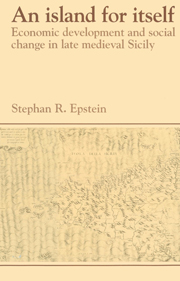Book contents
- Frontmatter
- Contents
- List of maps
- List of tables
- Acknowledgments
- Abbreviations
- Currency and measurements
- Chronology
- 1 Introduction. The historiography and the sources
- 2 Regional geographic and demographic differentiation
- 3 Market structures and regional specialization
- 4 Sicily and its regions. Economic growth and specialization
- 5 Sicily and its regions. Eastern val Demone and the southern mainland
- 6 Foreign trade and the domestic economy
- 7 Income distribution, social conflict and the Sicilian state
- 8 A further question: the origins of Sicilian underdevelopment
- Bibliography
- Index
- Past and Present Publications
8 - A further question: the origins of Sicilian underdevelopment
Published online by Cambridge University Press: 06 January 2010
- Frontmatter
- Contents
- List of maps
- List of tables
- Acknowledgments
- Abbreviations
- Currency and measurements
- Chronology
- 1 Introduction. The historiography and the sources
- 2 Regional geographic and demographic differentiation
- 3 Market structures and regional specialization
- 4 Sicily and its regions. Economic growth and specialization
- 5 Sicily and its regions. Eastern val Demone and the southern mainland
- 6 Foreign trade and the domestic economy
- 7 Income distribution, social conflict and the Sicilian state
- 8 A further question: the origins of Sicilian underdevelopment
- Bibliography
- Index
- Past and Present Publications
Summary
This book has offered a critique of theories of dependence through trade in the Middle Ages and has suggested an alternative model for the late medieval economy. In the course of the argument, however, I have raised many questions which cannot, at the present state of our knowledge, be pursued any further. On the one hand, the extent to which the view developed here is applicable to western Europe as a whole can only be tested through further empirical research on other regions; indeed, the institutional approach I have advocated assumes that further analysis of the kind I have pursued here is necessary for further theoretical refinement. Such research may establish that late medieval Sicily achieved an unusual degree of market integration and specialization for the time; but I have provided theoretical grounds for arguing that specialization was a process common to the whole of western Europe, and that regional differences were a matter of (possibly significant) degree. On the other hand, if my critique of current theories of economic dualism and dependency applies to late medieval Sicily, which had one of the most export-oriented economies in Europe at the time, these arguments can be presumed to hold all the more for other, less export-oriented areas in medieval Europe to which similar dualist theories have been applied. Recent work on eastern Europe in the early modern period is also beginning to raise similar questions and suggest comparable answers to mine.
- Type
- Chapter
- Information
- An Island for ItselfEconomic Development and Social Change in Late Medieval Sicily, pp. 402 - 412Publisher: Cambridge University PressPrint publication year: 1992

